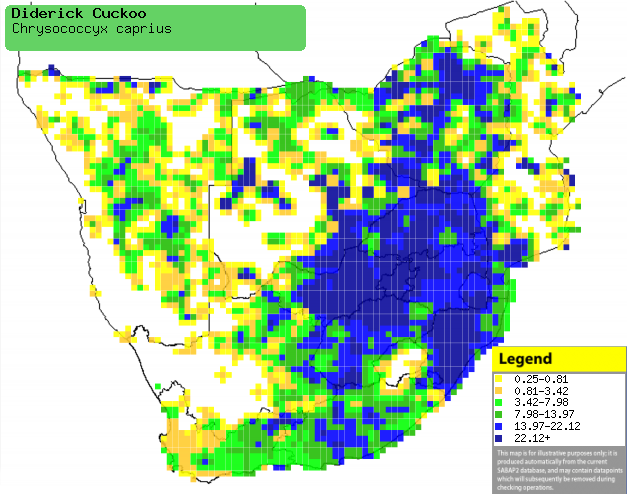|
Chrysococcyx caprius (Diderick
cuckoo)
Diederikkie [Afrikaans]; Umgcibilitshane [Xhosa];
uNononekhanda [Zulu]; Ntetekeng [South Sotho]; Goudkoekoek,
Diederikkoekoek [Dutch]; Coucou didric [French]; Diderikkuckuck,
Goldkuckuck [German]; Cuco-bronzeado-maior [Portuguese]
Life
> Eukaryotes >
Opisthokonta
> Metazoa (animals) >
Bilateria >
Deuterostomia > Chordata >
Craniata > Vertebrata (vertebrates) > Gnathostomata (jawed
vertebrates) > Teleostomi (teleost fish) > Osteichthyes (bony fish) > Class:
Sarcopterygii (lobe-finned
fish) > Stegocephalia (terrestrial
vertebrates) > Tetrapoda
(four-legged vertebrates) > Reptiliomorpha > Amniota >
Reptilia (reptiles) >
Romeriida > Diapsida > Archosauromorpha > Archosauria >
Dinosauria
(dinosaurs) > Saurischia > Theropoda (bipedal predatory dinosaurs) >
Coelurosauria > Maniraptora > Aves
(birds) >
Order: Cuculiformes > Family: Cuculidae
The Diderick cuckoo is common in large areas of
southern Africa, and lives in wide variety of habitats. It feeds exclusively on
invertebrates, especially caterpillars. It is a brood parasite, laying its eggs
in other birds nests, about 1 per nest but 22-24 can be laid in the whole
breeding season. It destroys any eggs that the host has laid before laying its
own, after
which it leaves and is often mobbed by the host. Within the first three days of
hatching, the cuckoo chick eats any the other eggs or chicks that weren't in the
nest at the time of laying. It stays in the nest for about 19-22 days, and out
of the nest, the chick remains with its adopted parents for about 21 more days.
Distribution and habitat
Occurs across sub-Saharan Africa, generally preferring
forest edges, mesic savanna, closed woodland, semi-arid shrublands, parks and
gardens, occasionally moving into Mopane (Colosphermum mopane) woodland.
|
 |
|
Distribution of Diderick cuckoo in southern Africa,
based on statistical smoothing of the records from first SA Bird Atlas
Project (©
Animal Demography unit, University of
Cape Town; smoothing by Birgit Erni and Francesca Little). Colours range
from dark blue (most common) through to yellow (least common).
See here for the latest distribution
from the SABAP2. |
Call
A plaintive call that most commonly, put into words, sounds like "dee-dee-dee-dee-deederik".
Predators
Food
Mainly eats invertebrates,
especially caterpillars but also termites and even the eggs of its host. It
typically forages in the foliage of trees and bushes, gleaning prey from leaves
and stems, and
occasionally flying down to the ground to pick up a prey item. The following
food items have been recorded in its diet:
-
Insects
-
caterpillars (larval stage of
Lepidoptera)
- Anadasia punctifascia (Chestnut eggarlet)
- Bombycomorpha bifasciata (Barred eggarlet)
- Imbrasia belina (Mopane emperor moth)
- Acraea
-
termites
- Eggs of its hosts
Breeding
- It is a brood parasite, meaning that it lays its eggs
in other birds nests. The host, thinking that the egg is its own, incubates
the egg and cares for the chick. The following bird species have been
recorded as host of the Diderick
cuckoo:
- Egg-laying season is from October to March.
- Before laying the egg, it waits for the potential host to leave the
nest and than flies in to inspect it. If it is suitable then it will
either throw the existing eggs out the nest, or carry them to a nearby perch
to eat them. Once the eggs have been removed, it lays one egg (rarely two).
The cuckoo female is often mobbed and chased by the host bird. It
lays 3-5 eggs a day, and 20-24 eggs are laid in the 10-12 week
breeding season.
- It is sometimes killed by its potential host; in one example a male was
mobbed and killed by Southern
masked-weavers. Also, females sometimes get stuck in the nest entrance
and are pecked to death by
Lesser masked-weavers,
- Within the first three days of hatching, the chick eats any other eggs or chicks
that weren't present at the time of laying. It is fed by the host, staying in the nest for about
19-22 days, after which the chick remains with its adoptive parents for about 21
more days.
Threats
Not threatened, in fact its distribution range seems to
have expanded recently.
References
-
Hockey PAR, Dean WRJ and Ryan PG (eds) 2005. Roberts
- Birds of southern Africa, VIIth ed. The Trustees of the John Voelcker
Bird Book Fund, Cape Town.
|
